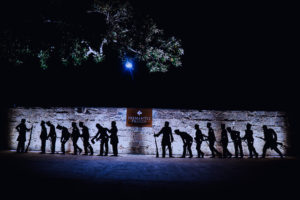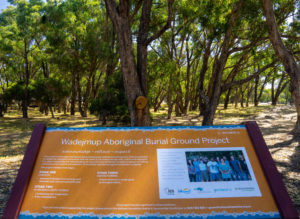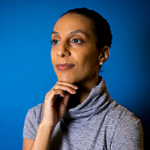He was the one who didn’t belong. A white man sitting at the end of a row of Black women. Yet he was clutching a microphone on his lap. A group of Anangu women artists and ngangkari (healers) had travelled 2,000 kilometres from their remote desert communities to teach a group of academics and artists how they delivered health, social, and cultural services to their communities spread across a region encompassing 350,000 square kilometres. Although it looked small on a map, the extensive size of the Australian continent was coming into view. I had travelled to Australia to learn about the individual and societal impacts of intergenerational trauma that still linger from the 80-year forced migration of 162,000 convicts, including children as young as nine years old, who were imprisoned in chain gangs and on isolated housing estates. While learning about the brutality of the convict system, I tripped over the equally important and traumatic story of displacement and incarceration of Indigenous peoples.
The first Anangu speaker raised a microphone to her lips. Her long skirt lifted just above her ankles and stretched as she leaned forward to rest her elbows on her knees. I realized why the white man was there: to interpret Pitjantjatjara into English. Her voice was soft and the audience listened like she was our mother telling us a bedtime story. When it was time for the interpreter to speak, he paused between sentences, whispering to the women. A white Australian who worked as a ranger in Central Australia, he had been interpreting Pitjantjatjara to English speakers for many years. He was seeking more information to ensure he accurately conveyed their intentions to the predominantly white audience. I had never seen such deference given to Indigenous peoples before. We need to do this in Canada, I said to myself. I tried to imagine what that would be like: Indigenous first-language speakers in Canada expressing their lives through an interpreter. Before I was swept into my fleeting daydream, I realized I didn’t actually know whether or not this was done in Canada. I was too lacking in facts to make such a prescriptive comparison. I placed my pen down and squished my notebook closed. I couldn’t get the elastic to wrap around the outside; the hardcover wouldn’t bend.
Like remote Indigenous communities in Canada, the Anangu talked of their communities’ struggles with mental illness and suicide—a devastating consequence of centuries-long displacement and separation from their traditional territories and customs. By the time I visited Australia, I already knew that trauma persists even if the original traumatic event has disappeared. In 2016, I spent two weeks backpacking in the Balkans after a family wedding in Greece. I had seen a movie about Sarajevo, heard about the city’s beauty, and could not resist the urge to visit while I was in Europe. Amongst the stillness of the Dinaric Alps and along the ripples of the Neretva river, I was confronted with the aftermath of devastation of the Balkan Wars of the 1990s. Bombed out buildings that had never been reconstructed, bullet holes that had never been plugged, and memorials of a genocide where the bodies are still being recovered and identified. But it wasn’t until I visited Kata Tjuta and Uluru, the iconic rock formations making up Australia’s most famous landmarks, that I finally understood, in a visceral sense and not only an intellectual sense, the long-lasting trauma of colonialism on the land and its people.
The burnt orange of the sandstone rock that towers over the desert was a reminder of the suffocating heat at midday. Even though Uluru had been returned to its traditional owners in 1985, the damage had already been done. Walking along the base of Uluru and walking to Walpa Gorge at Kata Tjuta, all of the places had names and stories: like the Kulpi Minymaku, a long opening on the side of the rock that looked like it had been made smooth by tidal waves. It was a kitchen cave where women taught their daughters how to process food. The tour guide explained the importance of Uluru as a place where Anangu people could get water in the middle of the desert. Water is life. That made Uluru more than just an ancient rock; it was also the sustenance of a community.
 I realized the truth about why I felt more moved by the suffering of Indigenous peoples in Australia: I saw myself in them. Their dark skin and deep brown eyes reminded me of family photos that hung on the walls of my parents’ home. One morning, I was sitting at the kitchen table in the log cabin I rented near Port Arthur, Tasmania’s notorious convict site that had the British Empire’s first separate boys’ prison. I was two weeks into my three-month trip and needed to organize my itinerary. I was going to Western Australia in two months to visit Fremantle Prison and was looking for local leisure activities. Outside the window an echidna waddled through the brush. Its spines swayed as it plunged its long black snout into the dirt searching for ants. I had heard about Rottnest Island, a popular vacation destination for locals and tourists living in the Perth region. Before Rottnest Island was a famous destination popularized by a native marsupial, the quokka, it was a prison for Indigenous men and boys. It played an important role in conquering and colonizing Western Australia. It was also the site with the largest deaths in custody in Australia with over 370 former prisoners buried in unmarked graves under a field of leaning tea trees. This, a burial ground that was only marked in 2015, only recognized in 1985. Before non-Indigenous people knew it was a burial ground, it was used as a campsite. I nailed it to my itinerary.
I realized the truth about why I felt more moved by the suffering of Indigenous peoples in Australia: I saw myself in them. Their dark skin and deep brown eyes reminded me of family photos that hung on the walls of my parents’ home. One morning, I was sitting at the kitchen table in the log cabin I rented near Port Arthur, Tasmania’s notorious convict site that had the British Empire’s first separate boys’ prison. I was two weeks into my three-month trip and needed to organize my itinerary. I was going to Western Australia in two months to visit Fremantle Prison and was looking for local leisure activities. Outside the window an echidna waddled through the brush. Its spines swayed as it plunged its long black snout into the dirt searching for ants. I had heard about Rottnest Island, a popular vacation destination for locals and tourists living in the Perth region. Before Rottnest Island was a famous destination popularized by a native marsupial, the quokka, it was a prison for Indigenous men and boys. It played an important role in conquering and colonizing Western Australia. It was also the site with the largest deaths in custody in Australia with over 370 former prisoners buried in unmarked graves under a field of leaning tea trees. This, a burial ground that was only marked in 2015, only recognized in 1985. Before non-Indigenous people knew it was a burial ground, it was used as a campsite. I nailed it to my itinerary.
Before I left Rottnest Island, I wanted to learn more about the prison’s history, where almost 4,000 Indigenous prisoners were forced to labour. I entered a small art gallery; an artist was working on his paintings. The small squares were plastered along the walls. Each one carefully placed so there was only a few inches between images. The wood floor creaked beneath my feet as I turned towards an open entranceway leading to a room in the back corner. Inside: a television set, a few rows of chairs, and a giant poster for the film directed by Glen Stasiuk, Wadjemup: Black Prison—White Playground.
I picked up the remote resting in front of the television and glanced at the instructions. It was late in the afternoon and figured I would watch the movie until I was asked to leave. I nestled into the wooden chair. Its flat back made it impossible to slouch. Even though I had read about the history of the prison, I didn’t know what to expect.
They were strong men; they were important men. Chained by shackles suffocating their necks, they were forced to march for kilometres towards boats on the coast. Overcrowded prison cells awaited them on the other side. Tired, hungry, they stumbled their way through the dirt. Heads hunched forward, they gripped their iron bars to pull them away from blistered skin. Each foot uneasily placed in front of the other. Their skin glistened as the sun revealed the sweat on their chests. The man at the front of the chain collapsed, his black hair swept across his face. A man riding a horse alongside them, his coat buttoned all the way to his chin and face protected under his hat’s sun brim, stopped. He grabbed the rifle lying across his lap and shouted, “Keep moving you Black bastards!” I was suddenly aware of my solitude in the small, well-lit room. My right hand gripped the handle of my backpack, the left was squished between my thigh and the wooden seat. The floor still creaked as the artist installed his images in the other room. My discomfort was on full display, and now was not the time to be interrupted.
When Rottnest was still a prison, the Quod was where Indigenous prisoners were forced to live seven men and boys in 5.5 foot by 10-foot cells. After the prison was closed, the walls were scrubbed and the cells transformed into hotel rooms for tourists. But there is never enough scrubbing to cleanse a society of its traumatic history. There can only be rebuilding of something anew. And justice supplies the building blocks for that new society.
 It was at the “Anxiety, Culture, and the Future Conference” hosted by the University of New South Wales (UNSW) in Sydney where the Anangu women spoke about rebuilding their communities. At the conference, UNSW Professor Jill Bennett explained the limitations of empathy. Inside the auditorium was crisp from the air conditioning. The vents hummed as I strained to listen. She said, empathy can lead to stigma because it’s often directed towards ingroups. We see ourselves in others and so we can feel and understand their pain. This shared sense of pain propels an individual’s desire to help improve the lives of others. I shifted in my seat; my rib cage rocked to each side and my right ear dropped towards my shoulder. The tip of my pen pressed into my notebook as I realized there were no other Black people in the audience. The biggest problem with empathy, she said, is that it privileges the holder of the empathy and not the person who is harmed.
It was at the “Anxiety, Culture, and the Future Conference” hosted by the University of New South Wales (UNSW) in Sydney where the Anangu women spoke about rebuilding their communities. At the conference, UNSW Professor Jill Bennett explained the limitations of empathy. Inside the auditorium was crisp from the air conditioning. The vents hummed as I strained to listen. She said, empathy can lead to stigma because it’s often directed towards ingroups. We see ourselves in others and so we can feel and understand their pain. This shared sense of pain propels an individual’s desire to help improve the lives of others. I shifted in my seat; my rib cage rocked to each side and my right ear dropped towards my shoulder. The tip of my pen pressed into my notebook as I realized there were no other Black people in the audience. The biggest problem with empathy, she said, is that it privileges the holder of the empathy and not the person who is harmed.
During my years of studying the history of race and slavery in North America as an undergraduate and PhD student, I had forgotten the main purpose of justice. I had made justice about myself and my own knowledge of the past. I assumed I understood how people are marginalized in Canada because I read about them in a book written by whichever historian my professors said was reputable in the field. But as I learned about the ways Indigenous peoples in Australia lived, I realized I actually didn’t know what the lives of Indigenous peoples living in Canada were like. And worse, I wanted to superimpose what I thought was most meaningful and transformative. Not necessarily what Indigenous peoples wanted. Growing up as a first-generation Black woman in Canada whose parents both had graduate degrees, I learned to place too much worth in traditional knowledge and education. Sitting in that auditorium, I began to shiver. Not from the cold breeze that was still shooting out of the vents, but from the sudden realization that I had been devaluing other forms of knowledge and intelligence in the same way that others devalued the things that I knew because of their source.
An integral part of the opening procession for the conference was a Welcome to Country ceremony. Expecting a typical land acknowledgement, I waited for a high-ranking white person to fidget with their paper as they stumbled through Indigenous names they had not practiced saying before, as I had too often witnessed at events in Canada. Instead, it was an Indigenous person who led the ceremony. Unlike land acknowledgements in Canada, the power and presence of an Indigenous person in Australia performing a Welcome to Country ceremony felt real.
This ceremony must be performed by traditional custodians of the territory where an event is taking place and can’t be performed by an Indigenous person from another region or a non-Indigenous person. It’s meant to welcome visitors to their traditional lands. Even though Welcome to Country ceremonies predate the arrival of Europeans, they still serve as a reminder of colonialism and the displacement of peoples that ensued. Having an Indigenous person address the crowd reminded us that Indigenous peoples are alive, rather than fixtures of a past that is so often misremembered. The Gadigal elder, Uncle Charles (Chicka) Madden, welcoming us to his people’s lands in that over-air-conditioned auditorium in Sydney brought a sense of connection that I had never experienced before. A land acknowledgement was like sitting through a lecture. Cold, sterile. I know why I should be interested but I struggle to see the significance. But having an Indigenous person literally welcome me to their land brought home how the land truly is a space that we share together. And that is why we must take care of it—and take care of each other.
Yet, my desire for change was hindered by my limited knowledge of the processes that had to take place for us to get to where we are. If I was going to toss aside Canadian land acknowledgements in favour of a ceremony similar to Welcome to Country, I at least had to know whether Indigenous peoples were dissatisfied with current land acknowledgements and whether they would be interested in leading alternative ceremonies.
The more I’m educated, the more education has become part of my identity. Affording me a space to carve out my own voice. Upheld by society’s acceptance of these accomplishments as something of value. Since I completed my Master’s in History, I have been invited to share my knowledge about Canadian politics and racism in the national media. The increasing attention I received helped to solidify my belief in the primacy of my own education and experiences at the expense of those whom I wanted to help gain justice for. I fell prey to what d’bi.young anitafrika explains in Room Magazine’s Women of Colour issue, “We have been taught systems where accolades and certain praises coming from a particular space is worth more than my Black sister saying to me that your work is profound to me and every day it shifts my soul.”
I am slowly learning to shed an inner fear I have of looking unintelligent. I realize loosening my grip on my own knowledge is pivotal to achieving justice. I had to see there was something missing before I could grow. A gap that could be filled with love, respect, and appreciation for other peoples who may not have suffered in the way my people have suffered, but whose historical trauma is just as present. I spent three months traversing Australia to stand in the shadows of one the largest forced migration of convicts in modern history. Even through this history, I left feeling that the presence of Indigenous peoples, their lives, and their histories was louder there than in Canada, and I wanted it to be the same in Canada. But were their lives and their histories really louder, or was I not listening at home?

 Angela Wright is a writer and communications professional. Her creative nonfiction has appeared in Catapult, The Fiddlehead, The New Quarterly, and in the award-winning anthology, Black Writers Matter. She researched part of her first book in Australia, which unravels the individual and societal impacts of trauma, with the support of the Canada Council for the Arts and the Ontario Arts Council.
Angela Wright is a writer and communications professional. Her creative nonfiction has appeared in Catapult, The Fiddlehead, The New Quarterly, and in the award-winning anthology, Black Writers Matter. She researched part of her first book in Australia, which unravels the individual and societal impacts of trauma, with the support of the Canada Council for the Arts and the Ontario Arts Council.